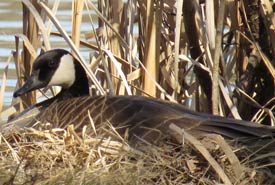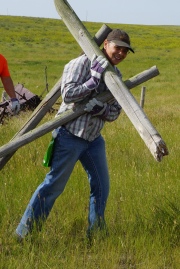Lessons learned from Mother Goose: How I learned to appreciate Canada geese through three seasons of careful observation

Canada goose (Photo by Denise Harris)
Sometimes we don’t know what we have until we lose it, and that is exactly how I feel about Canada geese this spring. This year, I have discovered the territorial a flock of Canada geese who conveniently bred in my urban backyard for the last two years and who had accepted my presence have not returned.
Two seasons ago, a nesting goose (who I decided to name Mother Goose) made a decision that would change my perspective on geese, although I didn’t know it at the time. Within just a few minutes of our meeting, Mother Goose decided I was a friend and not a foe. Her acceptance of me not only triggered my curiosity, but allowed me to observe her and her flock members’ private lives. I’ve learned a bit about their communication, a bit about their family bonds, as well as community ties that unite the flock. I discovered their different personalities, dedication to the brood and reaction to adversity.
My observations of Mother Goose taught me how female geese bond with their offspring before introducing them to the crèche (groups of goslings that are taken care of by adults that are not necessarily related to the goslings). From her, I learned that geese may adopt a second nester’s offspring, taking time away from the protection of the crèche to bond with the new goslings. Mother Goose demonstrated her wisdom by sharing her responsibilities with her prior year’s juveniles in the rearing and protection of her blended, second-nestlings family. She guided and protected her offspring so that they may lead a successful life.
Last season, my observations of Mother Goose’s behaviour ultimately established, for me, the parallels rather than the differences between our species. Four evenings after her arrival, she started construction of her nest and laid her first egg. Amazingly, she laid the egg without uttering a sound or twitching a muscle, it would seem to avoid drawing attention to her vulnerable predicament.
I learned from her the importance of bathing after egg laying: to clean up and remove any smell from her feathers. She demonstrated her respect for, and perhaps protection of, her nest site by not defecating around it. She cared for her unhatched eggs gently. Her attention to the eggs’ temperature requirements demonstrated her self-sacrificing need for food, water and exercise.
From her, I learned that in geese, full-time incubation does not commence until after the last egg is laid. When she came off the nest to support her mate in a territorial battle, and in doing so failed to incubate her eggs, she disclosed the wisdom of sacrificing a single clutch rather than the potential greater loss of her nesting territory, foregoing today for a better tomorrow. She and her mate shared their grief by spending an hour or so staring at their lost clutch while resting close by. Then with resilience, they picked themselves up and started over.
During Mother Goose’s fourth day of egg-laying, humans startled her while she was upon the nest. Her cry alerted her mate. Stretching as tall and wide as he could, he ran hissing towards the intruders, ensuring his position was maintained between the intruders and his extremely vulnerable family. This was the second day in a row where human activities had interrupted her while laying her eggs and it became the first day when she began nesting full-time.
This year, I’ve been reminded to never take anything for granted, for when we do, we lose it. Now, a new, inexperienced couple has moved into Mother Goose’s territory, and the new gander has already let me know that he was uncomfortable with my presence, with one soft hiss.
This season, I am reminded how sometimes when the stars align just so, unique opportunities present themselves. I am grateful to Mother Goose and the rest of the flock, for without their tolerance I would not have learned as much, nor would I have been reminded of so many gifts their species has shared and continue to share with our species.


